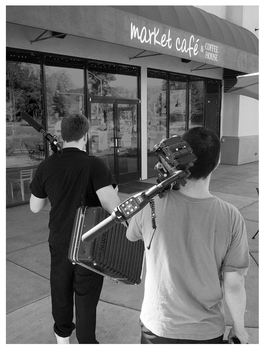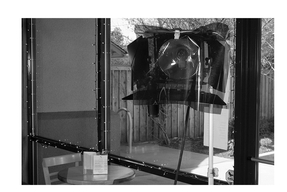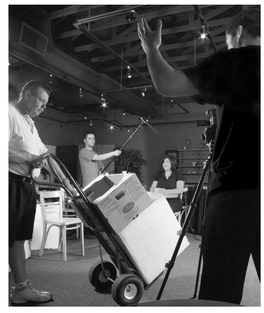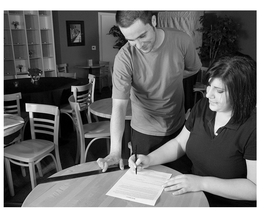27
The Right Place at the Right Time
James Williams

Figure 27-1
Scouting locations ahead of time is a great way to avoid last-minute surprises and big headaches on the day of your shoot.
Consider this: a scene in your short film takes place in a coffee shop. You know you could never pass off your living room as the local java joint, so you decide to shoot that scene on location. It’s time to hit the road and find the right spot. There are several elements to keep in mind:
Identify Your Power Source
Power outlets are essential for lights, batteries or other equipment. For such important elements, these power sources are easily overlooked. As you scout the location, ask yourself:
- Are there enough outlets that work?
- Are outlets close enough to where you’ll set up lights and camera? If not, how many extension cords will you need?
- Are the outlets grounded?
- Can the location handle the wattage of all of your equipment without tripping a breaker?
If you plan to use a generator, make sure you can place it far enough away that it won’t cause audio issues or create a safety hazard. For an event video, plugging into an outlet may not be an option, When scouting, look for out-of-the-way outlets for recharging a spare battery.
Evaluate Lighting Conditions
OK, so you find a coffee bar that has the exact look and feel you want. As you gaze around, you notice several large windows. Break out your tape measure, because you’ll probably need to give these windows some attention.

Figure 27-2 Mixed lighting can be a major problem on location. Having control temperature blue (CTB) will help spread more daylight temperature light onto the scene.
Combining outdoor sunlight with indoor, tungsten lights can create a look that’s either too blue or too orange when viewed through a video camera, particularly when human skin tones are involved.
The reason is that each light source has a unique color temperature that the camera readily picks up. It looks OK to the human eye, because our brain compensates for the color differences, but the camera simply cannot. The result is that the outdoor light looks blue and the indoor light looks orange through the viewfinder. White balancing won’t always solve the problem.
The solution is to choose which lighting temperature you’d like as your primary light source, then eliminate or add filters to the other source, so all light in the room has the same color temperature.
Fluorescent lights cast a greenish hue, so most videographers turn fluorescents off altogether or swap the fluorescent bulbs with specialty bulbs that give off the desired color temperature.
As you consider your lighting situation, some questions to ask are:
- Are you using the windows as a light source?
- What are the dimensions of the windows, in case filters (gels) or other light-blocking materials are needed?
- Where are the controls to turn off the overhead lights?
- If you’re swapping out fluorescent bulbs, what sizes are the replacements?
Anticipate Audio Problems
Few locations are completely devoid of noise. Scouting your location in advance allows you to hear how quiet the room really is.
Stop walking. Close your eyes and listen. It turns out the room is noisier than you thought. Rumbling softly overhead is a huge AC vent. An espresso machine sputters behind the counter. A telephone rings in the next room. Traffic noise leaks in from the street.

Figure 27-3 Store owners have to have their refrigerators up and running. You can reduce noise using sound blankets. Brings lots of them.
Catching these sounds now allows you to make adjustments. Ask yourself:
- Can you turn off, unplug or cover up any unwanted sources of noise?
- Where is the quietest spot, and is that a good place to shoot the scene?
Bring a mic and headphones to hear how the room sounds to the camera. Check wireless mics for electrical interference or static from nearby equipment or radio towers. Can’t get a clean signal? Consider a wired lavalier or shotgun mic.
Consider the Time and Day of the Week
Most places, especially public places, look and sound different at different times of

Figure 27-4 Your shooting schedule and the day-to-day business of the location may have some conflicts. Ask the owner in advance if you should expect any after-hours business or deliveries.
day or night. A side room may be completely quiet at 5 pm on Saturday but noisy as a roadhouse Wednesday after work. Sunlight that was soft and indirect at 9 am may be extremely harsh and blazing into the room by 3 pm.
Some things to consider are:
- How might ambient light changes affect your plans or need for filters?
- How might changing traffic patterns, such as rush hour or sporting events, affect your audio?
- Will any other people occupy the same location while you’re shooting? How disruptive will their presence be?
Consider what aspects of the location will change with the day of the week. If you’re shooting on a Tuesday morning, you’ll want to know ahead of time that Tuesday mornings are when the delivery guy comes. Nobody wants to pause their production every few minutes so delivery dollies can be rolled through the set.
Visit your locations at the same time and same weekday that you’ll be doing your shoot. If that’s not possible, ask someone familiar with the area what to expect at the time you plan to be there. Most people don’t think in terms of poor audio or other hurdles that can hold up a production. A cleaning crew vacuuming before the place opens might not seem like a big deal to the owner, but it’s enough to bring your production to a halt. Tailor your questions accordingly.
Getting the Logistics
Location scouting for video shoots and event videos is a great time to assess shot angles, camera setups and any logistical considerations. Bring a camcorder along to preview your shot list or record details of the space.
Some other useful observations you might want to make are:
- Where’s the best place to unload equipment and store unused gear?
- If you’ll need to rearrange the room, what extra equipment or personnel will be required to do so safely?
Get Permission
Once you’ve found the ideal location for your shoot, you’ll need permission to shoot there. Many folks are OK with letting you use their property for your productions, as long as they know exactly what you’re doing and how long it will take.

Figure 27-5 Don’t forget the location and talent releases. Always have more than you need, just in case something unexpected happens. It’s best to have everyone sign before you shoot.
When you are asking permission, it’s always a good idea to:
- Be polite!
- Be upfront and honest about crew size and time requirements.
- Explain that they will get exposure for the location and it will be noted in the credits.
Make sure that the person who is granting you permission to do the shoot signs a release form, even if you have had a verbal OK. That release form will come in handy if anyone questions your right to be there on the day of the shoot or anytime after that.
If you’re shooting in a public space, check well in advance whether a permit is required. Permit requests can often take more time to process than you anticipate, and, without the right paperwork, you may find your production shut down before you even get started.



